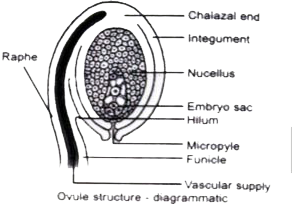With a suitable diagram explain the structure of an ovule . Structure of ovule (Megasporangium) : Solution in Tamil
Ovule is also called megasporangium and is protected by one or two covering called integuments . A mature ovule consist of a stalk and a body . The stalk or the funiculus (also called funicle ) is present at the base and it attaches the ovule to the placenta . The point of attachment of funicle to the body of the ovule is known as hilum. It represents the junction between ovule and funicle. In an inverted ovule . the funicle is adnate to the body of the ovule forming a ridge called raphe . The body of teh ovule is made up of a central mass of parenchymatous tissue called nucellus which has large reserve food materials . The nucellus is enveloped by one or two protective coverings called integuments . Integument encloses the nucellus completely except at the top where it is free and forms a pore called micropyle . The ovule with one or two integuments are said to be unitegmic or bitegmic ovules respectively. The basal region of the body of the ovule where the nucellus integument and the funicle meet or mege is called as chalaza. There is a large , oval, sac - like structure in the nucellus toward the micropylar end called embryo sac or female gametophyte. It develops from the functional megaspore formed withing the nucellus. In some species (unitegmic tenuinucellate) the inner layer of the integument may become specialized to perform the nutritive function of the embryo sac and is called as endothelium or integumentray tapetum (Example : Asteraceae.)

Topper's Solved these Questions
- ASEXUAL AND SEXUAL REPRODUCTION IN PLANTSBOOK - FULL MARKSCHAPTER - ASEXUAL AND SEXUAL REPRODUCTION IN PLANTSEXERCISE - Additional Questions (1- Mark Questios)
60 Videos
- ASEXUAL AND SEXUAL REPRODUCTION IN PLANTSBOOK - FULL MARKSCHAPTER - ASEXUAL AND SEXUAL REPRODUCTION IN PLANTSEXERCISE - Additional Questions (2- Mark Questios)
49 Videos
- APPLICATIONS OF BIOTECHNOLOGY BOOK - FULL MARKSCHAPTER - APPLICATIONS OF BIOTECHNOLOGY EXERCISE - HIGHER ORDER THINKING SKILLS (HOTs) QUESTIONS
7 Videos
- BIODIVERSITY AND ITS CONSERVATION BOOK - FULL MARKSCHAPTER - BIODIVERSITY AND ITS CONSERVATION EXERCISE - Higher Order Thinking Skills (HOT) Questions
5 Videos
Similar Questions
Match the following :
(1) Conidia (i) Yeast(2) Budding (ii) Bacteria (3) Gamma cups(iii) Aspergillus(4) Binary fission(iv) Marchantia
View SolutionWrite the name of organisms that undergo the following of asexual reproduction.
(a) Budding (b) fragmentation (c) Regeneration (d) Gemma cup formation.
View SolutionThe immune system of a person is suppressed,. In ELISA test, the result is positive
(i) Name the disease associated with condition.
(ii) Why did he loose his immunity?
View SolutionWhat will be the result, if the relationship between species richness and area for wide variety of taxa are plotted on a long scale?
View SolutionTHE PISTIL,MEGASPORANGIUM (OVULE) AND EMBRYO SAC
View SolutionWith a suitable diagram explain the structure of an ovule.
View SolutionWith a suitable diagram explain the structure of an ovule.
View SolutionDescribe the structure of anatropous ovule with labelled diagram.
View SolutionMEGASPORANGIUM - OVULE || MEGASPOROGENESIS
View SolutionWith a suitable diagram, explain the structure of an ovule.
View SolutionName the tissue that nourishes the embryo in angiosperm seeds. Explain its types. Structure of ovule (Megasporangium ):
View SolutionExplain the structure of typical angiospermic ovule.
View SolutionDescribe the structure of Megasporangium with a diagram
View SolutionDescribe the structure of ovule of a gymosperm, along with a labelled diagram.
View SolutionGynoecium || Structure OF Ovule || Types OF Ovules
View Solution
